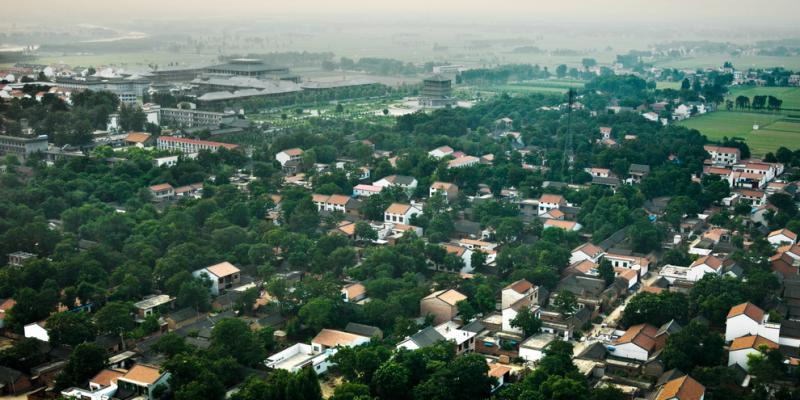
陳家溝村全貌
?
??? 河南省溫縣陳家溝,位于溫縣城東六公里的清風(fēng)嶺中段。村南隔黃河相望有虎牢關(guān)、伏羲臺、河洛匯流處等。距陳家溝西北不遠處有道教圣地陽落山“二仙廟”,西南一百公里處有少林寺,道教文化、佛教文化與儒教文化都在這里匯集,形成了推動中華文明發(fā)展厚重的中原文化。
??? 明朝初年,陳家溝陳氏始祖陳卜從山西移民到此,便帶有家傳武術(shù)。這里溝壑交錯、兵匪出沒,經(jīng)常騷擾百姓,為了保衛(wèi)桑梓,村里成立了武學(xué)社,陳家溝人習(xí)武成風(fēng)。這里特殊的人文地理環(huán)境和厚重的中華傳統(tǒng)文化對陳王廷創(chuàng)編太極拳產(chǎn)生了深遠影響。
??? 陳王廷(字奏庭,1600~1680),陳家溝陳氏第九代人,出生于明萬歷二十八年,明武庠生,清文庠生。其祖陳思貴,任陜西狄道縣典史;其父陳撫民,曾任征士郎,均好拳習(xí)武。
??? 陳王廷自幼勤奮好學(xué),晝練武,夜習(xí)文,不但深得家學(xué)真?zhèn)鳎鲱惏屋停沂熳x諸子百家,學(xué)識淵博,文武兼?zhèn)洌谌担Ψ蛏詈瘢谐说妮p功絕技。年輕時走鏢山東一帶,掃蕩群匪,匪寇聞“名”喪膽。晚年,陳王廷隱居鄉(xiāng)里,以《黃庭經(jīng)》為伴,潛心研究易學(xué),收集整理民間武術(shù)。他理根太極,秉承中國傳統(tǒng)的“天人合一”思想和陰陽生克之理,在家傳拳術(shù)的基礎(chǔ)上,將眾家武術(shù)之長融匯合成,加上自己平生習(xí)武所悟,融中醫(yī)經(jīng)絡(luò)學(xué)與道家導(dǎo)引吐納術(shù)為一體,創(chuàng)編了一種剛?cè)嵯酀㈥庩柣セ⒆兓媚獪y、威力無比的武術(shù)拳種——“太極拳”。
?? 陳王廷所傳授下來的有五路拳、五路捶、108式長拳,雙人推手和刀、槍、劍、棍、锏、雙人粘槍等器械。其中雙人推手和雙人粘槍,更具有前所未有的獨特風(fēng)格。
??? 步入陳家溝,就猶如步入了太極文化的圣地。這里有令人敬仰的太極拳歷代宗師紀念館,有響譽國內(nèi)外的中國太極拳博物館,有充滿傳奇色彩的楊露禪學(xué)拳處。
??? 1982年,因為太極拳的影響,國務(wù)院確定溫縣為“甲級對外開放縣”;1992年11月,國家體委命名溫縣為第一批全國“武術(shù)之鄉(xiāng)”;2006年5月20日,國務(wù)院公布太極拳為第一批國家級非物質(zhì)文化遺產(chǎn);2007年6月2日,中國民間文藝家協(xié)會命名溫縣為“中國太極拳發(fā)源地”,并在溫縣建立“中國太極拳文化研究基地”;2007年7月31日,中國武術(shù)協(xié)會命名溫縣為“中國武術(shù)太極拳發(fā)源地”;2008年8月20日,中國政府啟動太極拳申報聯(lián)合國人類非物質(zhì)文化遺產(chǎn)代表作工作;2010年4月,溫縣被世界華人華僑社團、中華文化促進會、國際休閑經(jīng)濟促進會聯(lián)合授予“中國十大文化休閑旅游縣”榮譽稱號;2011年9月,溫縣與河南登封、河北滄州一起,被評為“最受全球網(wǎng)民關(guān)注的中國武術(shù)之鄉(xiāng)”,且名列榜首。
??? Chenjiagou is located in mid-Qingfeng ridge, five kilometers from southeast Wen County. In the south of the village, across the Yellow River are Hulaoguan, Fuxi Station, Heluo Confluence. Not far from the northwest of Chen village, there is a Taoism Holy Land—— Yangluo mountain " Erxian Temple ", 100 km southwest of the village is Shaolin Temple. Taoism culture, Buddhist culture and Confucian culture are brought together here, formed massive culture of Central Plains promoting the development of Chinese civilization.
The early Ming Dynasty, Chen family ancestor Chen Bu immigrated Chenjiagou from Shanxi, the family martial arts was brought here. In the village, the gully interlocked, soldier bandit infested and often harassed people. In order to defend the homeland, the village established martial arts club, Chenjiagou people practicing martial arts had become a trend. The special human geographical environment and heavy Chinese traditional culture has had a profound impact on Chen Wangting creating Tai Chi.
??? Chen Wangting (word Zouting, 1600-1680), is Chenjiagou Chen’s ninth generation. He was born in the twenty-eight years of Ming Dynasty, was Wuxiang in late Ming Dynasty and Wenxiang in early Qing Dynasty. His grandfather Chen Sigui, had been Dianshi of Didao county in Shanxi; his father Chen Fumin has been Zhengshilang, they were both good at boxing and Martial Arts.?
??? Since childhood, Chen Wangting has been studious boy, he practiced martial arts in the day and studied theories at night. He not only won the family fortune and rose above the common herd, but also perused with all classes of authors, he was knowledgeable, well-educated and trained in military exercises. Besides, he was skilled in Tai Chi and instruments, and has solid Kongfu and Qinggong foundation. When he was young, he served as a bodyguard on Shandong journey, mopping up the group of bandits, bandits trembled with fear on hearing of his name.
??? In his later years, Chen Wangting lived in Chenjiaou, researched The Book of Changes with Huangtingji to collect folk martial arts. Taking theory of Tai Chi as the root, adhering to the Chinese traditional idea “nature and human unity” and the generation and restriction of Yin and Yang, meanwhile, based on Chen family’s boxing, Chen Wangting absorbed the quintessence of kinds of martial arts, melting with Chinese main and collateral channels, Taoist guidance and deep breathing to create a martial arts set pattern—Tai Chi which has hardness and softness, interaction of yin and Yang, unpredictable change and powerful strength.
??? The handed down Tai Chi of Chen Wangting are routine five boxing, routine five beating, 108 types long boxing, double pushing hands and knife, gun, sword, stick, mace, double glue gun and other equipments. Especially the double pushing hands and double glue gun have unprecedented unique style.
??? Walking into Chenjiagou just like entering into the Holy Land of Tai Chi culture. There are admirable memorial halls of Tai Chi masters in all ages and legendary Yang Luchan Learning Place. Chinese Tai Chi Museum is known at home and abroad.?
??? 1982, because of the impact of tai chi, the State Council named Wen county“Class A County Opening up”; November 1992, the State Sports Commission named Wen County as the first batch of “National Martial Arts Village”; May 20, 2006, the State Council announced Tai Chi for the first batch of National Intangible Cultural Heritage; June 2, 2007, the Chinese Folk Literature and Art Association named Wen County "Birthplace of Chinese Tai Chi”, and founded“Chinese Tai Chi Cultural Research Base”; July 31, 2007, the Chinese Martial Arts Association named Wen County“Tai Chi Birthplace of Chinese Martial Arts”; August 20, 2008, Chinese government started Tai Chi declaration of the United Nations Human Intangible Cultural Heritage representative work; April 2010, Wen County was awarded the honorary title of“Top Ten Chinese Culture and Leisure Travel County” jointly by World Chinese and Overseas Chinese Communities, Chinese Culture Promotion Society and the International Association for the Promotion of Leisure Economy; September 2011, Wen County together with Dengfeng and Cangzhou, were named “the Most Popular Chinese Martial Arts Village that Global Netizen Concerned About”, and Wen County was on the top.
?
